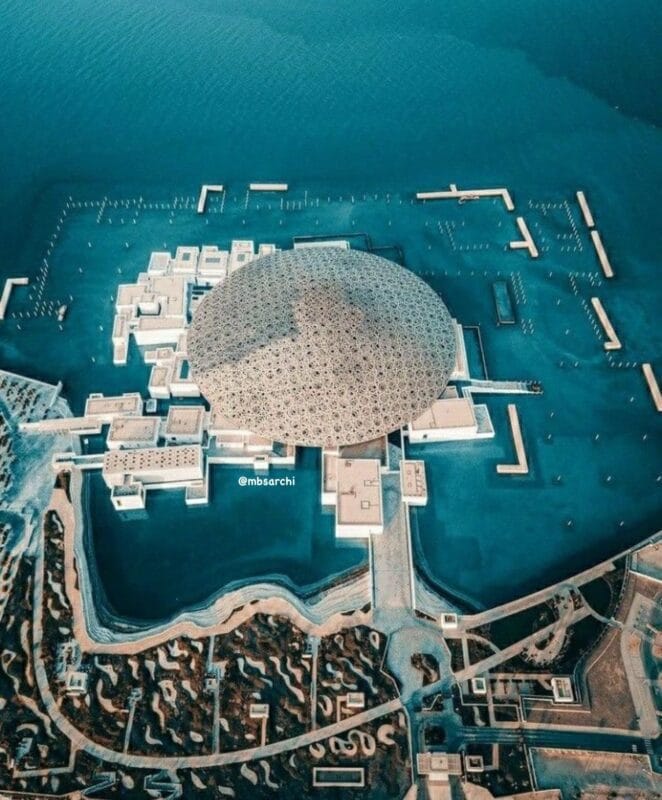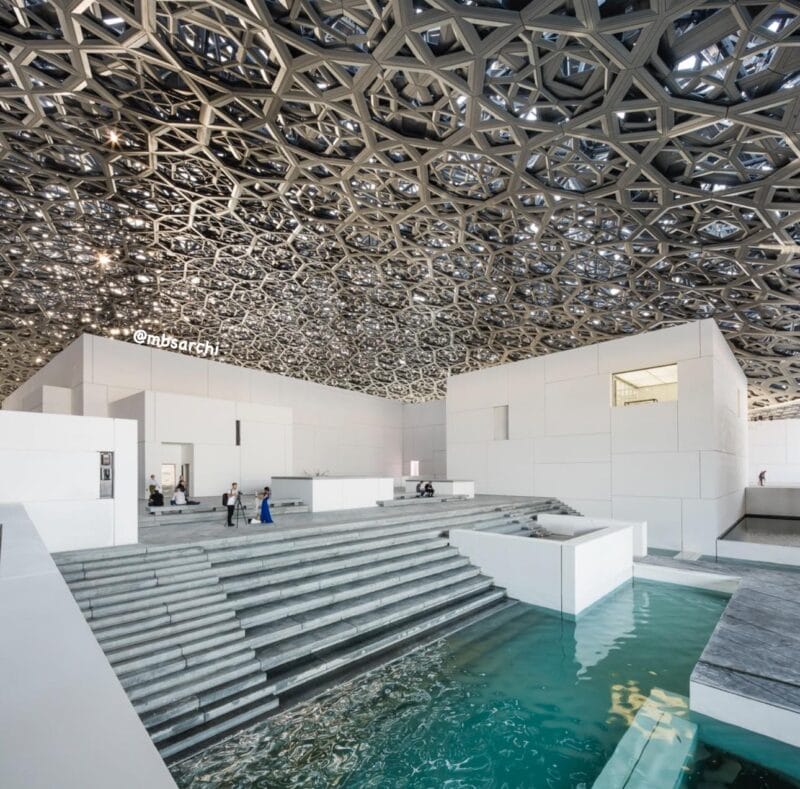
Louvre Abu Dhabi: A Cultural Masterpiece by Jean Nouvel

The Louvre Abu Dhabi by Jean Nouvel, located in the capital of the United Arab Emirates, stands as a symbol of cross-cultural dialogue and artistic brilliance. Designed by the renowned architect, Jean Nouvel, this museum showcases a blend of modern architecture and cultural significance. Inaugurated in 2017, the Louvre Abu Dhabi has since become one of the most visited landmarks in the region, showcasing both ancient artifacts and contemporary works of art.
Architectural Brilliance of Jean Nouvel

Jean Nouvel’s design is a modern masterpiece that redefines the concept of museum architecture. The iconic Louvre Abu Dhabi by Jean Nouvel is known for its dome structure that creates the mesmerizing ‘rain of light’ effect.”
Nouvel’s signature piece is the museum’s geometric dome, which has become synonymous with the Louvre Abu Dhabi. Measuring 180 meters in diameter, this intricate dome consists of a pattern resembling a “rain of light,” an architectural feat that allows sunlight to filter through, casting beautiful patterns of light and shadow on the floors of the museum. This interplay of light symbolizes the connection between cultures and traditions that the museum itself aims to represent.
Design Inspiration: A Modern Oasis
Jean Nouvel’s design for the Louvre Abu Dhabi draws heavily from the traditional architecture of the Arab world, particularly the ancient Arab medinas and falaj water systems. The open, airy spaces of the museum are inspired by traditional courtyards, creating a sense of calm and openness.
The dome is reminiscent of a traditional Islamic architectural element, a muqarnas, which serves as both an artistic and functional element, shielding the galleries from the harsh desert sun while creating an awe-inspiring visual effect inside the museum. The museum’s location on Saadiyat Island further enhances its connection with nature, surrounded by water, with a design that feels both futuristic and deeply rooted in tradition.
Cultural Significance and Global Vision

The Louvre Abu Dhabi is not just a museum; it represents a bold vision for cross-cultural dialogue. It is the result of a historic collaboration between the UAE and France, serving as the first universal museum in the Arab world. The institution aims to foster a deeper understanding between different cultures through art and education, showcasing collections from across the globe, from ancient civilizations to contemporary works.
The “rain of light” dome itself is symbolic of this dialogue, illustrating how art and culture transcend boundaries, much like the beams of light that pierce through the intricate structure to illuminate the gallery spaces below. Inside, visitors encounter works of art that span thousands of years and dozens of cultures, from Egyptian antiquities to contemporary Middle Eastern art, providing a comprehensive view of human creativity.
Sustainability and Innovation

In addition to its cultural importance, the Louvre Abu Dhabi is also a model of sustainable architecture. Jean Nouvel incorporated advanced environmental design principles to reduce the museum’s carbon footprint. The large dome not only serves as a visually stunning element but also plays a key role in reducing energy consumption by shading the museum’s interior and promoting passive cooling.
The museum’s structure is designed to withstand the extreme climate of the UAE, employing innovative cooling techniques and sustainable construction materials to ensure it remains comfortable for visitors while minimizing environmental impact.
The Louvre Abu Dhabi’s Impact on the UAE
The Louvre Abu Dhabi has significantly impacted the cultural and architectural landscape of the United Arab Emirates. By blending the rich history of the region with modernity, Jean Nouvel has created a symbol of progress and openness. The museum has bolstered Abu Dhabi’s reputation as a cultural destination, attracting visitors and scholars from around the world.
The Louvre Abu Dhabi, located in the capital of the United Arab Emirates, stands as a symbol of cross-cultural dialogue and artistic brilliance. Designed by Pritzker Prize-winning architect Jean Nouvel, this museum is not just an architectural marvel but also a cultural bridge that connects the rich histories of the East and West. Inaugurated in 2017, the Louvre Abu Dhabi has since become one of the most visited landmarks in the region, showcasing both ancient artifacts and contemporary works of art.
FAQ: Louvre Abu Dhabi
1. What is special about Louvre Museum Abu Dhabi?
Louvre Abu Dhabi stands out for its stunning architecture, designed by Jean Nouvel. The museum’s iconic dome creates a mesmerizing “rain of light” effect. This blends modern design with tradition. What also sets it apart is its unique collection, which showcases artworks from across the globe. The museum highlights connections between Eastern and Western cultures, offering visitors a chance to explore human history through art.
2. Is Louvre Abu Dhabi worth it?
Yes, it’s definitely worth visiting. Louvre Abu Dhabi is more than a museum; it’s a cultural experience. Its striking architecture and diverse collection offer a memorable journey through art and history. Whether you’re an art lover or simply curious, this museum provides something for everyone. Its serene location on Saadiyat Island only adds to the experience.
3. How much does it cost to go to the Louvre Abu Dhabi?
Ticket prices for Louvre Abu Dhabi vary. General admission is AED 63 (around $17 USD) for adults. Youth aged 13 to 22 can enter for AED 31.50 (around $8.50 USD). Children under 13, journalists, and students from UAE-based institutions may enter for free. For the latest pricing, check the official Louvre Abu Dhabi website.

